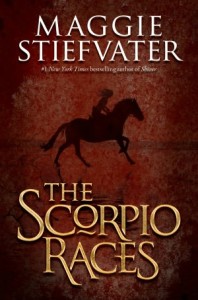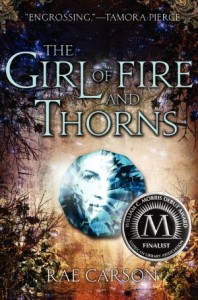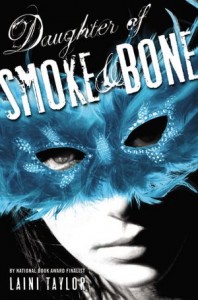Readers of this blog may not believe me when I say I’m not a big fantasy fan. Then why so many fantasy reviews? Because that’s what’s hot, friends. I hear that the pendulum is about to swing back to realistic fiction, but I’ll believe it when I see it. The good news is that some thought-provoking and literate fiction is being published in this field and, depending on preferences and maturity, some of it is worth reading. All three of the titles reviewed today appeared on several “Best of 2011” lists, some deservedly so and others maybe not so much.
The Scorpio Races, by Maggie Stiefvater. Scholastic, 2011, 404 pages. Age/interest level: 14-up.
Where is the Island of Thisby, in the Scorpio Sea? Where’s the mainland? It doesn’t really matter; even though some places in this world (like America) are factual, Thisby is ancient, mythic, and indistinct, a place that over half its population longs to escape. Puck (Kate) Connolly is not one of them: her roots go deep, and so to the roots of Sean Kendrick, even though his father was killed in the Island’s signature event when Sean was only ten. Or perhaps because of that. For Thisby is best known for the annual races of the capail uisce (copple-ISH-ka), or water horses—carnivorous, ocean-bred beasts, bigger, faster, and fiercer than their land-based cousins. Capail uisce can be caught and tamed to some degree, or at least enough to run in the race that takes place every year on November 1.
This year Puck is determined to participate because she and her brothers (also orphaned by the water horses) desperately need money to save their property. No female has ever entered the race: “The women are the island, and the island keeps us,” she’s told. “That’s important. But the men are what drive the island into the seabed and keep it from floating out to sea. You can’t have a woman on the beach. It reverses the natural order.” Even if it weren’t for her gender she would have no chance on her land horse Dove, especially matched against Sean and his water horse Corr. She persists however, and eventually Sean comes around. Maybe they could both win. But the bastard (in all ways) son of Sean’s boss Benjamin Malvern, the richest man on the island, is determined to thwart them both.
Superficially there’s plenty to object to: coarse language, mild profanity, and sexual innuendo, though no sex. But the religious context is worth exploring. Though nominally Catholic, the Island reserves its true devotion for ancient pagan myths, tied directly to the water horses. This shows in the comparison between the Hotel, all painted columns and polished arches and cornices, with the Malvern stable, a dark stone structure held up by carved wooden columns showing men stacked upon men, the topmost with a horse’s head. The connection between mainstream religion and ancient myth is endlessly fascinating, as our discussion of the Hero’s Journey indicated. Water horse legends seem to be mostly Gaelic, but I’d like to know more about the actual animals. Where are they from? How are they bred? Do they have gills? The story is thin on some details, and the pace is rather slow, but it gets its power from strong characterization and excellent writing. Some questions to think about are: 1) How does Thisby contrast to the mainland? What do you think this contrast means? 2) The people of Thisby speak of God, but what do they actually worship?
- Worldview/moral value: 3.5 (out of 5)
- Literary value: 4.5
 The Girl of Fire and Thorns, by Rae Carson. Greenwillow, 2011, 423 pages. Age/interest level: 12-up.
The Girl of Fire and Thorns, by Rae Carson. Greenwillow, 2011, 423 pages. Age/interest level: 12-up.
“My sister hates me . . . Nurse Ximena says it’s because I was chosen by God for an act of service and Juana-Alodia was not.” Everybody knows Elisa is the chosen one because she bears the Godstone, a sapphire-like jewel embedded in her navel and divinely bestowed roughly every 100 years. Elisa is about to be married, as the story opens, to the king of the desert nation Joya d’Arena, whom she’s never seen. She hopes he’s ugly and old so she won’t fall in love with him. Unfortunately, he’s handsome and kind but doesn’t seem to have much genuine interest in her—and no wonder, as she is fat and awkward.
Her appeal for King Alejandro is obviously the Godstone, though its true significance remains hidden from her until she’s kidnapped and carried into the high desert by revolutionaries. The rough journey toughens her up and the tutelage of the desert priest Father Alentin wises her up to what’s at stake: the hostile Inviernes are terrorizing the frontier with supernatural power, and another supernatural power is required to thwart them. In true Hero-Journey style, Elisa doubts and disparages her calling, in spite of Alentin’s cautions: “You must not lose faith, child. No matter what. Do not doubt God or his choosing of you. He knows infinitely more than we can imagine.”
Elisa must learn how to use the gift bestowed on her, even while wishing she were rid of it. “’[God] was wrong and I’m done,’ she says, at a low point. “Maybe he’s not done with you,” replies her closest comrade. The story brims with Christian terminology and allusions, with Elisa as an obvious Christ figure, though she remains ambivalent almost to the end. Religious trappings are sometimes hauled out to decorate a standard love story (and there is a love story, which takes an unexpected turn). Here, however, the religious context is real–though not Christian in the end. Interesting characters and implications coupled with strong writing make it a worthwhile read, and if you wonder where Elisa takes her hard-won knowledge, the sequel due on September 18. A couple of questions: 1) What do you make of the last paragraph? and 2) Are some of the other characters more heroic than Elisa? Why is she the hero?
- Worldview/moral value: 3/5
- Literary value: 4.5
Daughter of Smoke and Bone, by Lainie Taylor. Little, Brown, 2011, 418 pages. Age/interest level: 16-up.
Spoilers ahead! I read this because I was getting it confused with Girl of Fire and Thorns—a natural mistake, especially since they were published around the same time and appeared on the same “best of” lists. Since it’s not a novel I would recommend, I’ll go ahead and tell you what it’s about.
The story is mostly backstory: Karou is apparently an independent, seventeen-year-old art student in Prague, but is actually the ward and agent of a human-beast amalgam (a chimeron) called Brimstone. Via magic portal, Brimstone can send Karou anywhere in the world in search of teeth, which (backstory) he uses to resurrect chimera who have fallen in war with the seraphim, who (more backstory) were supposedly created from a mating of the sun and one of the moons and are now in perpetual war with the chimera. “Seraphim were some high order of angels, at least according to the Christian myths, for which Brimstone had utter contempt, as he did for all religions.”
Meanwhile Akiva, a seraph, is going through the world scorching all the magic portals because his true love, a chimeron named Madrigal, was executed by chimera warlord Thiag for her forbidden liason with Akiva. But it turns out that Madrigal has been remade as Karou, which makes everything OK, right? No, because by the time we learn this, it must also be revealed that Akiva unknowingly destroyed Brimstone during his scorched-portal project, and Karou decides she can’t forgive him, even though they’ve enjoyed steamy love in both her manifestations. By the time this is all unraveled we’re primed for Book Two—but no thanks. There’s plenty of bad language, Jesus-profanity, and (non-graphic) sex. The author writes well and knows how to rivet the reader to her imagined world; her talents just aren’t used to very noble purpose.
- Worldview/moral value: 2
- Literary value: 3.5
?For more Christian/mythical connections, see our review of The Perilous Gard and the accompanying links.
Support our writers and help keep Redeemed Reader ad-free by joining the Redeemed Reader Fellowship.
Stay Up to Date!
Get the information you need to make wise choices about books for your children and teens.
Our weekly newsletter includes our latest reviews, related links from around the web, a featured book list, book trivia, and more. We never sell your information. You may unsubscribe at any time.
We'd love to hear from you!
Our comments are now limited to our members (both Silver and Golden Key). Members, you just need to log in with your normal log-in credentials!
Not a member yet? You can join the Silver Key ($2.99/month) for a free 2-week trial. Cancel at any time. Find out more about membership here.

